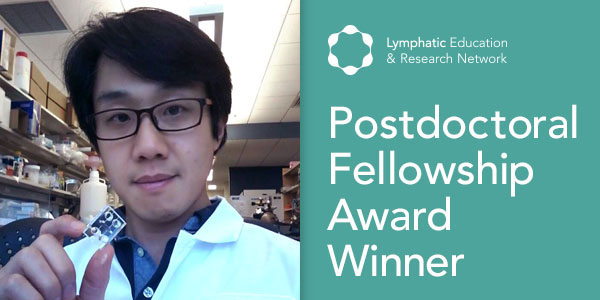Esak Lee, Ph.D., a Postdoctoral Fellow at the Wyss Institute for Biologically Inspired Engineering at Harvard University, Boston, MA, under the supervision of Dr. Christopher S. Chen and Dr. Donald E. Ingber received a LE&RN research fellowship in 2016. We asked Dr. Lee to tell us more about his research.
What is the focus of your research?
I focus on a biomimetic “Lymphatics-on-a-Chip” to replicate lymphatic function and lymphatic diseases. This model has three-dimensional (3D) engineered lymphatic vessels (LVs) recapitulating perfused lymphatics with specialized cell-cell junctions of initial and collecting LVs in vivo. Given that the initial and collecting lymphatics are connected in one system, I investigate lymphatic uptake, drainage, and transport of lymph molecules in continuous and quantitative manners. Specifically, I am developing a “Lymphedema-on-a-Chip” by introducing genetic mutations in lymphatic endothelial cells (LECs), and adding inflammatory cytokines to the system in order to tease out disease mechanisms and evaluate device utilities for drug screening.
What do you hope to learn from this research?
I would like to learn how cell-cell junctions are rearranged, especially in the initial and collecting LVs in lymphedema, since the lymphatic junctions have impacted on the overall lymphatic function. I also want to learn how LECs interact with stromal cells (e.g., smooth muscle cells, adipocytes, fibroblasts) in developing disease complications, such as lipedema and fibrosis. I am also interested in mechanotransduction in LECs on lymphatic sprouting, permeability, mural cell interaction, and valve formation. By adding a blood vessel to the LV-on-a-chip, I would like to understand how two distinct vessels are interacting each other in different contexts.
What impact do you foresee this research having on our current body of knowledge?
Lymphatic vessels have historically been shown to be crucial to the resolution of inflammation through the removal of excess fluids and inflammatory agents. However, accumulating data suggest that numerous mediators of inflammation dysregulate lymphatic function, which could be pivotal factors in the generation of chronic inflammation. However, phenotypic and mechanistic understanding of the lymphatic dysfunction in inflammation and their impact on lymphatic diseases are largely unknown. I hope my research can contribute to improving our knowledge to address these questions.
What clinical implications might grow out of this research?
A strength of this model is that multiple primary human cell types can be employed in 3D, then we can decouple and control micro-environmental parameters (flow, gradient, extracellular matrix (ECM), etc), which has been challenging in traditional 2D culture and animal models. Thus, I hope that this model would serve as a platform for drug screening for clinical trials by filling gaps between 2D in vitro and animal trials. For future applications, we need successful combinations of the systems with in vivo models for fast validation of the on-chip models; lymphedema patients originated cells, comparing to normal cells.
What might the field accomplish within the next few years?
I would like to provide easy platforms of the devices that do not require specialist expertise. If the model systems could be easily adapted by other laboratories, it will impact their future uses by a larger lymphatic research community.
LE&RN programs, like the Fellowship Awards program, are only possible because of our Supporting Members. Become a Supporting Member today, for as little as $5/month.

